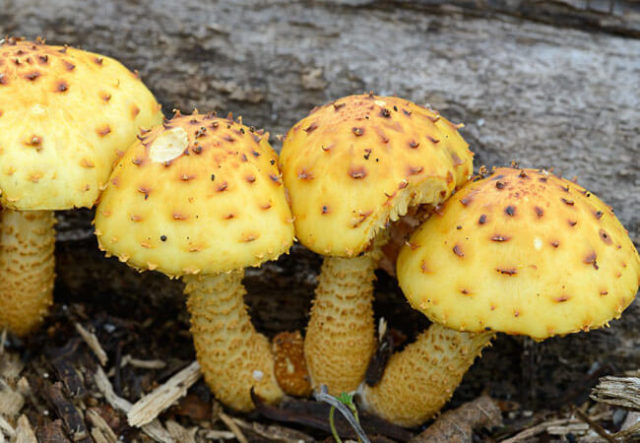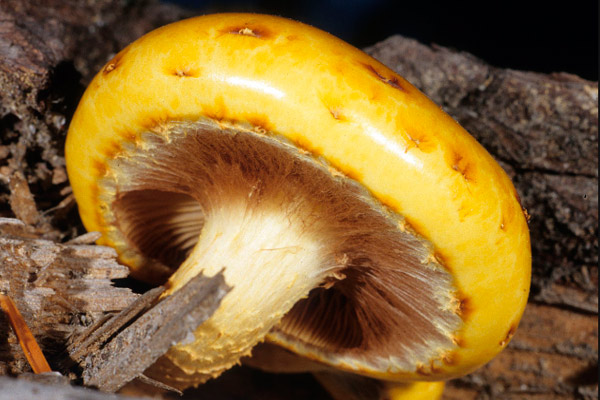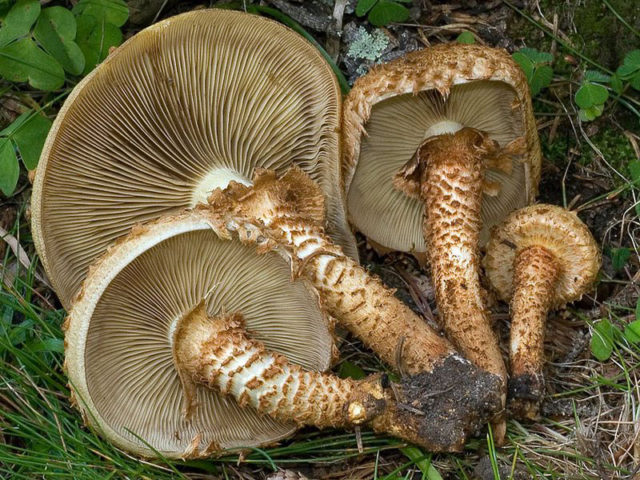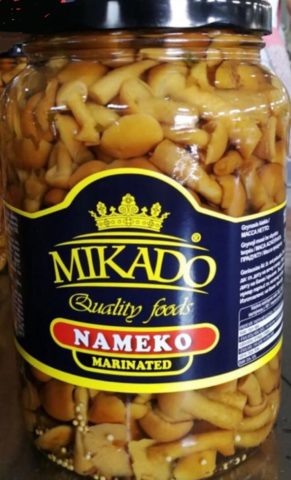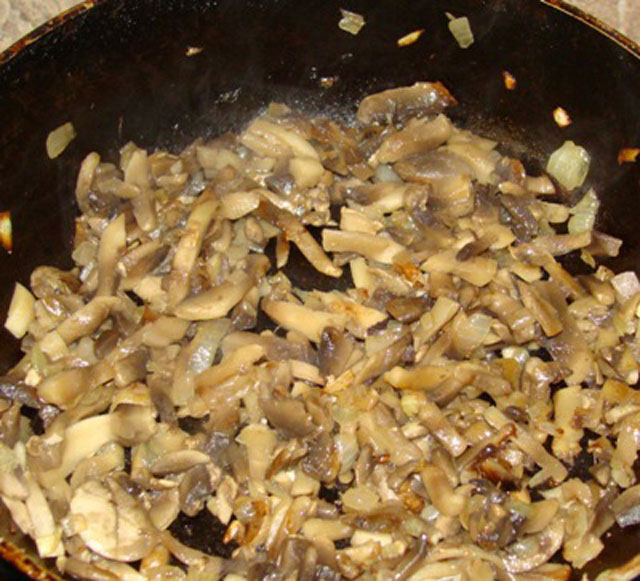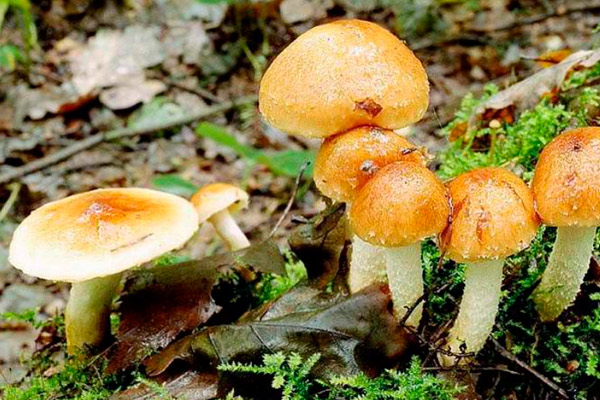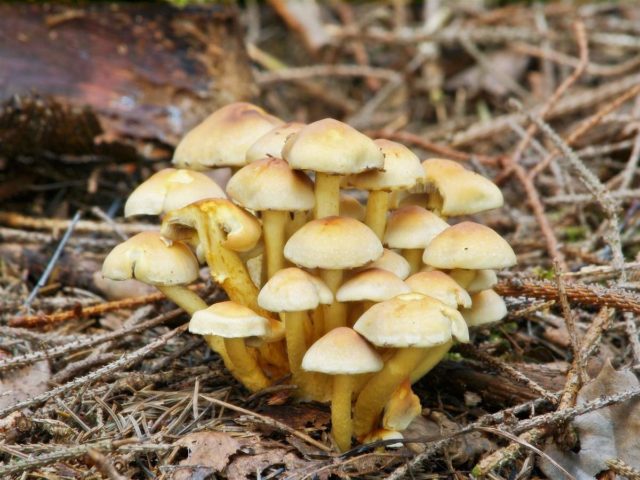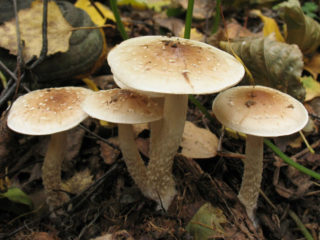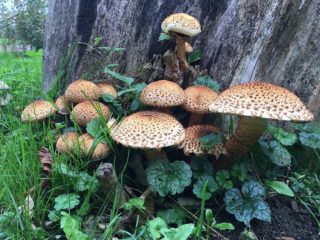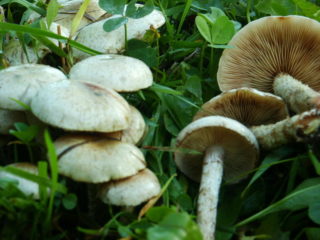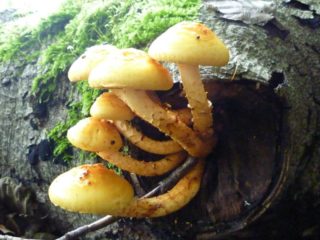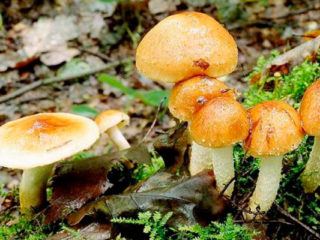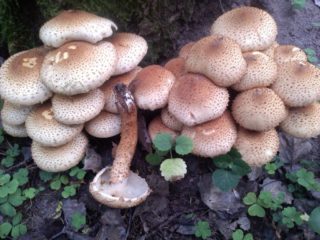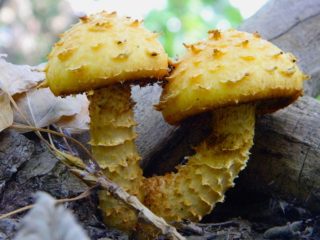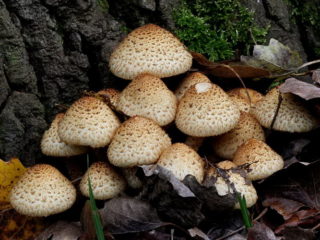Content
Royal honey fungus, or golden scale, in Russia is not considered a valuable mushroom, which mushroom pickers eagerly “hunt” for.But in vain, because it has quite high taste and medicinal properties. The main thing is to distinguish it in the forest from inedible representatives of the mushroom family.
Description of golden flake
Golden scale, or royal honey fungus (as well as Pholiota aurivella, willow, thick or greasy scale) looks really luxurious: a large bell-shaped cap covers a thin stalk with tiny scales. The size of the mushroom is 10 - 15 cm in height, but as it grows, the cap of the golden scale reaches a truly royal size - up to 20 cm and, unlike many poisonous analogues, does not change shape as its size increases.
Description of the cap
The cap of the young mushroom is bell-shaped, 5–6 cm in diameter, yellow in color with various shades of sand or rust. On top it is covered with small flake-like scales of a darker color than the color of the cap. During further growth, the cap straightens and takes on the shape of a wide bell. The lamellar hymenophore is hidden behind a white veil in young individuals; subsequently the veil is torn, leaving only a light felt fringe along the edge of the cap. As it grows, the dark scales on the cap become less noticeable.
Description of the leg
The leg of the golden scale is up to 10 cm long, up to 1.5 cm in diameter, yellowish-brown in color, completely covered with felt scales of a darker color, as clearly demonstrated in the photo of the mushroom. In young representatives, there is a ring on the leg formed from a rupture. In adults there is no ring.
Is golden flake edible or not?
Royal honey fungus belongs to the fourth category of mushrooms, which is designated as having minimal value from a gastronomic point of view. However, it is not only edible, but also beneficial for human health, as it has medicinal properties. The mushroom pulp has a somewhat specific taste, which is easily eliminated after a short soaking for 2 - 4 hours. When properly prepared, the taste of royal mushrooms is quite high. However, before any kind of cooking, they must be boiled.
How to cook golden flake
Main courses and marinated preparations are prepared from golden flakes, but only after first boiling the mushrooms for 15-20 minutes. They taste great with meat, potatoes and vegetables. Suitable for preparing stews, fillings for pies and assorted mushrooms. Mushrooms are prepared for the winter table in various ways:
- dried;
- salt;
- pickled.
Stewed dishes from royal honey mushrooms with the addition of milk or sour cream have high taste qualities.
How to pickle golden flakes
Marinating golden flake is the most popular way of cooking it. At home, you can prepare canned food that will not be inferior in taste to store-bought.
The algorithm of actions is as follows:
- Mushrooms are cleaned, sorted by size, washed thoroughly and boiled in salted water for 20 - 25 minutes.
- Place in a colander and allow the water to drain.
- Place in prepared, pre-sterilized jars.
- Add cloves, bay leaves, peppercorns, peeled garlic cloves.
- Prepare the marinade: add 2 tbsp to 1 liter of water. l. sugar, 2.5 tbsp. l. non-iodized salt. After boiling, add table vinegar - 4 - 5 tbsp. l.
- The marinade is poured over the prepared flakes and immediately rolled into jars.
How to fry golden flakes with onions
Preparing the easiest and at the same time delicious dish from golden flakes will not take much time, but will provide invaluable benefits to the body. Cooking algorithm:
- Mushrooms brought from the forest are cleaned, washed and boiled in salted water for 20 - 25 minutes.
- The mushroom mass is placed in a colander, the water is allowed to drain completely and placed in a frying pan with vegetable oil.
- Fry over high heat with the lid closed.
- When the moisture has evaporated, add onion rings, salt and pepper.
- Bring the dish to readiness and serve immediately.
The healing properties of golden flakes
Golden flake contains:
- vitamins;
- amino acids and minerals;
- fats;
- proteins;
- large amounts of phosphorus and calcium.
There are 2-3 times more useful components in royal honey mushrooms than in many other mushrooms. Therefore, we can say with confidence that representatives of this species bring invaluable benefits to the human body.The healing properties of royal honey mushrooms include an immunomodulatory effect, as well as a beneficial effect on brain activity and the ability to restore vitality. Mushrooms are also useful for anemia.
Where and how does it grow
The edible golden flake mushroom grows throughout Russian territory, as well as in Asia, Europe, Australia and America. Active growth occurs from mid-August to the end of September. Honey mushrooms prefer deciduous, coniferous and mixed forests, where they are located in large numbers on rotten stumps, rotting fallen trees, and turf soil overgrown with grass. It grows in especially large quantities in Primorye, where it delights mushroom pickers from early summer until late autumn.
Twins of golden flake and their differences
False doubles of golden scale:
- Mucous scale - is very similar to its edible counterpart, but with age the edges of its cap rise. Mushrooms are covered with mucus during the rainy season and have a small number of scales on the cap. They grow near dead wood or on rotten wood. The variety is inedible.
- False royal honey fungus, the hemispherical cap of which has a richly bright color and is also covered with scales, and straightens with age. However, it lacks the rings characteristic of edible species. False honey fungus is poisonous.
- Common flake has a very similar appearance to the golden representative of the family. It is distinguished by a pale color compared to golden flakes. The mushroom is medicinal and used for medical purposes.Important! The product contains opium, so it is not recommended for consumption.
A useful video will not allow you to confuse flakes with doubles during a quiet hunt
Conclusion
The golden scale, despite being called the royal honey fungus, is not its double and belongs to a completely different family. However, mushroom pickers undeservedly avoid these mushrooms: this species is not inferior to honey mushrooms in taste and healing properties.
